Howard Andrew Jones's Blog, page 36
January 18, 2016
The Fourth Gunman
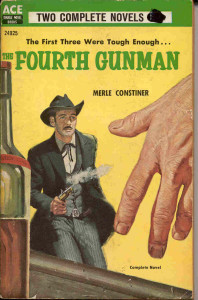 I never read a western in my life until some time in my mid ’40s when I got pointed to the excellent adventure novels of Ben Haas writing as John Benteen (or, indeed, several other pseudonyms). He proved to be such an excellent author that I sought out nearly everything the man wrote, and I’ve since been on a hunt for other great westerns from others.
I never read a western in my life until some time in my mid ’40s when I got pointed to the excellent adventure novels of Ben Haas writing as John Benteen (or, indeed, several other pseudonyms). He proved to be such an excellent author that I sought out nearly everything the man wrote, and I’ve since been on a hunt for other great westerns from others.
The problem is that there are thousands of westerns, and most of them seem to range only from okay to good, with the weight heavy on the okay end.
When you’re looking into fantasy or historical fiction it’s pretty easy to talk to some people in the know and get the lowdown on the recognized masters and the truly excellent. With westerns there’s less consensus. The trail usually ends with Louis L’amour or some other famous names that don’t really seem to be the most exciting. (L’amour is good, but in my experience he’s not great, no matter his popularity.)
So through the fall of 2015 an into the winter I’ve been exploring, based on some recommendations by John C. Hocking and Morgan Holmes, and working my way through some Harry Whittington, Donald Hamilton (better known for his Matt Helm books) and Merle Constiner.
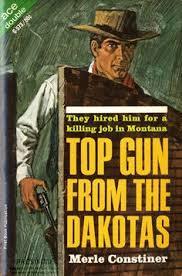 Whittington is good and capable but so far I’ve read only one that blew me out of the water. I’ll probably try more… except that I’ve had MUCH better luck with Donald Hamilton. Hamilton had so much success with his Matt Helm line that he didn’t write as many westerns, but he penned five, and I’ve read two of them and definitely rate them top notch.
Whittington is good and capable but so far I’ve read only one that blew me out of the water. I’ll probably try more… except that I’ve had MUCH better luck with Donald Hamilton. Hamilton had so much success with his Matt Helm line that he didn’t write as many westerns, but he penned five, and I’ve read two of them and definitely rate them top notch.
And Constiner — wow. He’s full of constant surprise, clever characters, action, mystery, and sparkling dialogue. So far my favorite has been The Fourth Gunman. When I write “constant surprise” this novel epitomizes it. The short opening chapter seems like it’s off to a slow start, and its protagonist a fairly ordinary if intelligent business owner. And then it twists into a mystery, and you quickly realize that the protagonist is more than he seems. Those sudden changes were so delightful I really don’t want to spoil it by going into detail aside from saying that there’s action and adventure and tension and a hero that’s great at thinking on his feet. If you are at all curious about westerns you should check it out, and if you like adventure stories, this might be a good entry point into reading westerns. Used copies (the only copies available) aren’t too expensive.
I’ve been reading more Constiner since. He has a slightly quirky, if good natured, style that’s quite distinct, so I don’t read too many in a row. A lot of them are more novelette length, sometimes packaged with another author’s work, or available in a two pack of Constiner. He’s consistently good an often great.
January 15, 2016
Conan Re-Read: “The Black Stranger”
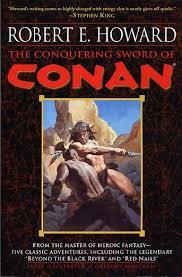 Bill Ward and I are reading through the Del Rey Robert E. Howard collection The Conquering Sword of Conan. This week we’re discussing “The Black Stranger.” We hope you’ll join in!
Bill Ward and I are reading through the Del Rey Robert E. Howard collection The Conquering Sword of Conan. This week we’re discussing “The Black Stranger.” We hope you’ll join in!
Bill: Like “Beyond the Black River” which precedes it, “The Black Stranger” is a tale set in the Pictish wilderness of Hyboria that sees a vulnerable outpost of civilization overrun by the wild men of the wood. But this time around the threat of the Picts — still an Amerindian analog — serve as more of a backdrop to the infighting and machinations of pirate captains, an exiled nobleman, and a cagey Conan. Again REH draws on the American frontier for inspiration, but it isn’t the dominant theme of the piece, which also manages to end on a far more up tempo note despite the carnage. Wild battles, double-crossing, pirate treasure, and a mysterious demonic stranger are all skillfully woven together into a complex but nonetheless fast-paced adventure that stands solidly alongside the better Conan stories.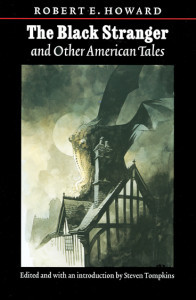
Howard: This one has been the most pleasant surprise out of the whole bunch. I had mis-remembered it as being a kind of unsuccessful mash-up of various elements, but I think now my bad impression probably had to do with my only previous reading of the story being with the version de Camp altered. I was expecting a bit of a slog, and it was a delight to find myself hooked by the opening section. Well, I thought, maybe it’s one of those that starts strong but then loses direction, like “The Vale of Lost Women.” No, it turns out that it just keeps going, with few if any mis-steps.
Bill: Weirdly enough, “The Black Stranger” is thought to have been rejected by Wright, and it was partially rewritten into a Black Vulmea story, which is certainly a more appropriate character and setting for the primary influences of the story. But the story itself, apart from what I feel is a slight pacing issue in the introduction of the two pirate captains in the early chapters of the piece, is a great deal of fun, and features Conan out-fighting, out-thinking, and out-shining every rogue, savage, and hellspawn that crosses his path. I think I’ll just have to finally concede defeat in trying to understand the tastes of the man who rejected this gem of a story (if that is indeed what happened) but raved about “A Witch Shall Be Born.”
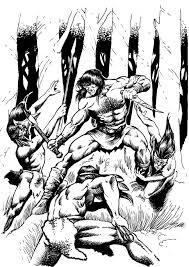 Howard: That’s mind boggling. If THIS was my most pleasant surprise so far during the re-read, “A Witch Shall be Born” was most my UNpleasant. Apart from the two scenes we discussed, that one feels more like a story outline, and Wright thought it was excellent. Yet he rejected this (probably), which starts with a bang and then just keeps going, with plenty of surprises and mystery and great action sequences. The opening chapter is among the best in the entire run of stories. You know, I’ve got the Black Vulmea version around here somewhere. I’ll have to read it and see what the differences are.
Howard: That’s mind boggling. If THIS was my most pleasant surprise so far during the re-read, “A Witch Shall be Born” was most my UNpleasant. Apart from the two scenes we discussed, that one feels more like a story outline, and Wright thought it was excellent. Yet he rejected this (probably), which starts with a bang and then just keeps going, with plenty of surprises and mystery and great action sequences. The opening chapter is among the best in the entire run of stories. You know, I’ve got the Black Vulmea version around here somewhere. I’ll have to read it and see what the differences are.
Bill: I understand the Black Vulmea version is shorter and tighter — perhaps REH dispensed with the Black Stranger subplot entirely? I think that could be done without sacrificing the really interesting parts of the story, which are the competing factions vying for lost treasure and a ship to carry it. While the titular character adds an air of creepy mystery and dread to the proceedings — and, of course, deliberately provokes the attack of the Picts on Valenso’s fort — I found the culmination of that plotline mildly disappointing. If Valenso’s madness had caused further chaos to the defenders or compromised the fort in some way it might have felt as well-integrated as every other aspect of the story, but this is an extremely minor criticism of a tale that, as you say, came as a very pleasant surprise to me as well.
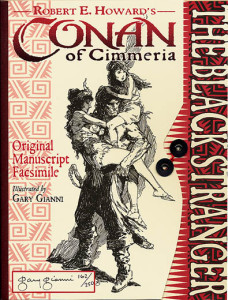 Howard: You’re right — the culmination of the Black Stranger storyline could have been kicked up a notch. I really did appreciate the slow reveal of it, though. That was handled masterfully. And before we get too much further I wanted to chime in and say I didn’t actually have a problem with the pace when Zarono showed up. Right when all hope seemed lost, here comes another pirate, and another problem. As well as an explanation of the cause of the previous problem. REH was really good about introducing multiple competing factions that have to work together without trusting one another.
Howard: You’re right — the culmination of the Black Stranger storyline could have been kicked up a notch. I really did appreciate the slow reveal of it, though. That was handled masterfully. And before we get too much further I wanted to chime in and say I didn’t actually have a problem with the pace when Zarono showed up. Right when all hope seemed lost, here comes another pirate, and another problem. As well as an explanation of the cause of the previous problem. REH was really good about introducing multiple competing factions that have to work together without trusting one another.
Bill: Another appealing aspect of the story is that it shows Conan’s sense of honor. Here again, with REH in frontier mode, it’s framed partially in racial terms as it was in “The Vale of Lost Women.” When you understand that the Picts here represent Native Americans, and that REH’s reading on the topic of the Picts in European history centered on now discredited theories of Picts as non-European, it makes more sense. To a modern reader it still gives pause — the historical Picts were, after all, a Celtic people more akin to Conan’s Cimmerians than to the Zingaran and Barachan “Mediterranean” people he decides to rescue. Of course, in Hyboria things are as REH presents them to be, and the real take away is that Conan, thoroughly barbarian, is yet both an honorable man at his core, and someone that draws a line at certain brands of savagery.
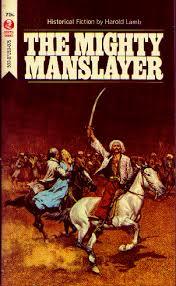 Howard: I do think that’s the way to look at it. And then we have to remember his line from the story when he comments that Cimmerians and Picts have an age old hatred.
Howard: I do think that’s the way to look at it. And then we have to remember his line from the story when he comments that Cimmerians and Picts have an age old hatred.
Bill: That’s very true, too — barbarians are also good at holding grudges. As always, however, it is civilized men who are the worst villains, aiming to betray one another with no qualms, making vows they never intend to keep, and falling upon one another as soon as their mutual suspicions seemed confirmed. Valenso, driven mad with a fear that his own dishonorable greed gave birth to, whips a child and intends to sell his niece as a bride to a vile pirate captain. Conan’s own intended betrayal of the captains — via a method possibly inspired by Harold Lamb’s “The Mighty Manslayer” — at least sticks to the letter of his agreement. It’s once he fails to kill Strom and Zarono and they and their men face torture at the hands of the Picts that Conan shows his sense of fair play — the Cimmerian might slay these men and take their ship and crew with a clear conscience, but he won’t leave them to the horrors of a people that he himself has just recently escaped. And, of course, Conan rescues Belesa and Tina from the clutches of a demonic entity at the end of the story, and gives them a bag of treasure, when he could have simply slipped away as the fort was overrun.
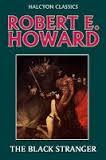 Howard: Several times Belesa’s youth is mentioned and I couldn’t help wondering if Conan’s more protective instincts towards her were called forth because she was just a little too young for him to think it appropriate to consider as a sexual partner, or if he thought that she was too soft and civilized. He’s capable of quite coarse and lusty behavior towards women, as we’ve seen in other tales, and yet here he seems not even to be tempted.
Howard: Several times Belesa’s youth is mentioned and I couldn’t help wondering if Conan’s more protective instincts towards her were called forth because she was just a little too young for him to think it appropriate to consider as a sexual partner, or if he thought that she was too soft and civilized. He’s capable of quite coarse and lusty behavior towards women, as we’ve seen in other tales, and yet here he seems not even to be tempted.
It’s interesting that you mention “The Mighty Manslayer” because there’s a choking gas that has very much the same effect upon protagonists in the tomb of Genghis Khan. As far as I’ve been able to determine — after digging through Howard’s letters and consulting with some REH scholars — it’s unclear that REH read earlier Lamb Cossacks stories; he seems to have discovered Harold Lamb during the second cycle of his Cossack heroes. That doesn’t mean he might not have found some way to read earlier tales. But a strange, choking gas in a treasure trove could have some other inspirational source.
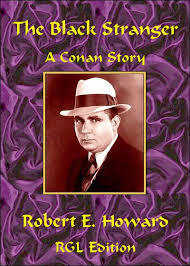 Bill: Having just re-read “The Mighty Manslayer” about a month ago, it was the first thing that leapt to mind. Of course, no reason this idea couldn’t be arrived at independently, or from other fiction I’m not even aware of, and in “The Black Stranger” it obviously doesn’t work out for Conan as it does for Khlit.
Bill: Having just re-read “The Mighty Manslayer” about a month ago, it was the first thing that leapt to mind. Of course, no reason this idea couldn’t be arrived at independently, or from other fiction I’m not even aware of, and in “The Black Stranger” it obviously doesn’t work out for Conan as it does for Khlit.
As for Belesa, I’m not sure if it’s specifically her youth so much as her vulnerability and, quite possibly, her role as a mother to Tina. There is a nice purity at the heart of what Conan did for them both, all without any hope of reward. I know REH often complained about the need to somewhat arbitrarily sex-up his stories, and keeping this relationship innocent was a nice way to further contrast Conan with the leering Zarono and callous Valenso. In my opinion it was certainly the right call on REH’s part in terms of audience expectation, so much so that I didn’t even think about it until you mentioned it.
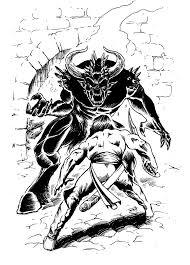 Overall I’d say “The Black Stranger” is the best of the frontier-inspired stories to date, possibly because I had a lot more fun reading it than I did the excellent but rather depressing “Beyond the Black River.” As we touched on last time, that REH wrote both kinds of stories, and a lot more besides, even within the milieu of one serial character, just shows what a tremendous talent he was, and how dedicated he was to his craft.
Overall I’d say “The Black Stranger” is the best of the frontier-inspired stories to date, possibly because I had a lot more fun reading it than I did the excellent but rather depressing “Beyond the Black River.” As we touched on last time, that REH wrote both kinds of stories, and a lot more besides, even within the milieu of one serial character, just shows what a tremendous talent he was, and how dedicated he was to his craft.
We’ve only got two stories left, one I remember liking a great deal and one, next week’s “Man-Eaters of Zamboula,” that I’m afraid to say I don’t remember at all.
Howard: I remember “Man-Eaters” being a bit of a dud, but I hope I’m wrong. I, too, enjoyed this one more than “Beyond the Black River” and I wonder if part of the appeal has something to do with several ongoing mysteries. Who, or what, is the Black Stranger? For several chapters after Conan’s initial appearance we can’t help wondering what’s happened to him, because his fate was left uncertain. Later we see that Belesa has no good choices and wonder how it will all work out with her… and how Conan will out think Strom and Zarono is a head scratcher. “Beyond the Black River” is arguably a more powerful, more deeply resonant work, but it doesn’t have the mystery to drive me forward and that’s another reason I liked reading this one better, even though it’s a little more on the purple end of the spectrum.
In any case, we’ll see you next week for the penultimate Conan adventure completed by Robert E. Howard.
January 13, 2016
Captain Nemo Sails Again
 We’ve had a few too many adventures here at Jones central lately. My son had a spin out on the highway on the way back to college. He was alright, thank goodness, but the car was damaged enough that we had to take him up the rest of the way, stay the night in his college town, then stop in the college town where he’d had the wreck and see about getting the car fixed. Fortunately no permanent damage was done, although the price of new tires was nothing to sneeze at, and then we headed home.
We’ve had a few too many adventures here at Jones central lately. My son had a spin out on the highway on the way back to college. He was alright, thank goodness, but the car was damaged enough that we had to take him up the rest of the way, stay the night in his college town, then stop in the college town where he’d had the wreck and see about getting the car fixed. Fortunately no permanent damage was done, although the price of new tires was nothing to sneeze at, and then we headed home.
Bill Ward and I are getting close to the end of our great Conan re-read and after having to write essays about so many tales we’re going to take a little breather, but we’ll be back to read more great adventure fiction.
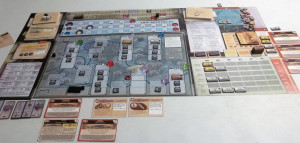 Today I wanted to share a nifty looking Kickstarter, Nemo’s War from Victory Point Games. I reviewed the first edition years ago at Black Gate. This new edition has had a complete visual re-design and some rules modifications. I went ahead and pledged my own nickels. Seems a little early to be buying a Christmas present for myself for next year, but it will turn up just in time to be under the tree in 2016. The picture here is of the BETA version of the board. It looks even cooler now.
Today I wanted to share a nifty looking Kickstarter, Nemo’s War from Victory Point Games. I reviewed the first edition years ago at Black Gate. This new edition has had a complete visual re-design and some rules modifications. I went ahead and pledged my own nickels. Seems a little early to be buying a Christmas present for myself for next year, but it will turn up just in time to be under the tree in 2016. The picture here is of the BETA version of the board. It looks even cooler now.
Here’s a link for a full write-up, with more pics and a description of play, and here’s a link to the Kickstarter itself, which shows close-ups of the cards, links to the gorgeous rulebook, and embedded links of a two part video that shows you how to play the game (which gives you a great sneak peek at the components).
Funding has blown through all the stretch goals, which means that there’s a ton of additional cards as well as some co-op rules for multiple players. (Nemo’s War was designed as a solitaire game).
Lastly, here’s my review of the original game, from 2011. Again, the NEW components have been completely re-designed.
Nemo’s War
Chris Taylor
Victory Point Games ($29.95)
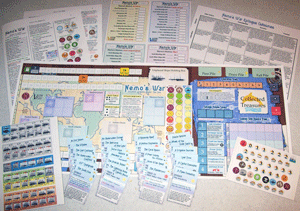 You may never have asked yourself what you would have done if you’d had a chance to command the Nautilus and all its amazing resources, but anyone remotely familiar with the premise of the novel’s undersea exploration and adventure during the Victorian Age should immediately see the promise of the idea. Nemo’s War gives you the Nautilus and all the seas of the world, but it also sends the ships of the navies of the world against you. The more of them you sink, the more of them come after you, but it’s not possible simply to avoid them, for once there are a certain number of ships on the ocean, Nemo automatically loses. That said, there are four different paths to victory. If you want to primarily seek out undersea adventure as a scientist or an explorer, you are welcome to do so. You can also launch an all-out war, or follow the novel more closely and set out to liberate the oppressed masses by blowing apart the warships and commercial vessels of the imperial powers. Each path tabulates its victory points differently.
You may never have asked yourself what you would have done if you’d had a chance to command the Nautilus and all its amazing resources, but anyone remotely familiar with the premise of the novel’s undersea exploration and adventure during the Victorian Age should immediately see the promise of the idea. Nemo’s War gives you the Nautilus and all the seas of the world, but it also sends the ships of the navies of the world against you. The more of them you sink, the more of them come after you, but it’s not possible simply to avoid them, for once there are a certain number of ships on the ocean, Nemo automatically loses. That said, there are four different paths to victory. If you want to primarily seek out undersea adventure as a scientist or an explorer, you are welcome to do so. You can also launch an all-out war, or follow the novel more closely and set out to liberate the oppressed masses by blowing apart the warships and commercial vessels of the imperial powers. Each path tabulates its victory points differently.
The game is made with simple but attractive pieces, including a three-fold map, a rule book, a pair of the world’s tiniest useful dice, and a whole slew of cardboard chits. Most of these are enemy ships, some of which journey onto the ocean automatically, some of which venture forth when you draw the wrong card, and some of which actively hunt you only when you become infamous enough to earn their wrath. In addition to the treasures you can seek on the seabed, you can upgrade the Nautilus by salvaging the ships you wreck, and incite rebellion among native peoples, which adds to your possible victory points. Along the way you will pull event cards that challenge your resolve. These are randomly shuffled moments from the novel, and to succeed against them you must roll higher than the challenge rating on the card, adding two dice together. If you wish to risk the crew, the hull, or even Nemo’s sanity, you can add a few extra points to the die roll, but if you still fail, those categories are lowered a notch.
Nemo is, simply, a joy to play. You begin pushing cardboard chits around a piece of paper but are soon engaged in a highly involved game of strategy and resource management. Fulfilling those victory conditions and reaching the highest point value (the more victory points, the better the result) is a terrific and enjoyable challenge.
January 8, 2016
Conan Re-Read: “Beyond the Black River”
 Bill Ward and I are reading through of the Del Rey Robert E. Howard collection The Conquering Sword of Conan. This week we’re discussing “Beyond the Black River.” We hope you’ll join in!
Bill Ward and I are reading through of the Del Rey Robert E. Howard collection The Conquering Sword of Conan. This week we’re discussing “Beyond the Black River.” We hope you’ll join in!
“Barbarism is the natural state of mankind,” the borderer said, still starring somberly at the Cimmerian. “Civilization is unnatural. It is the whim of circumstance. And barbarism must ultimately triumph.”
Bill: So concludes “Beyond the Black River,” a story that might almost be REH’s thesis on his philosophy of civilization. It is a story that introduces new elements to Conan’s world, demonstrating again how flexible and expandable REH’s Hyborian blueprint was even after sixteen complete short (and not so short) stories and a novel. But it also maintains a continuity with what has come before, giving us perilous adventure with supernatural antagonists and, of course, Conan being Conan.
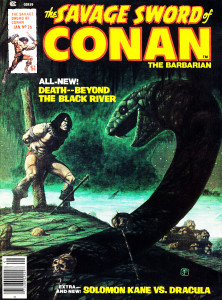 Howard: I think it builds nicely on what we’ve seen before. As it happens, though, it’s not exactly a great introduction to Conan himself, or even the Hyborian Age. It was the first Conan story I was ever handed to read, and I bounced right off of it, delaying my engagement by the world of Conan and the writing of Robert E. Howard for at least three more years, and I have forever after shaken my head at the wisdom of the person who handed me this tale to start with. It’s very different from the preceding Conan stories, feeling very much like a tale of Indian warfare, and Conan himself, while busy doing incredible things, is almost a secondary character.
Howard: I think it builds nicely on what we’ve seen before. As it happens, though, it’s not exactly a great introduction to Conan himself, or even the Hyborian Age. It was the first Conan story I was ever handed to read, and I bounced right off of it, delaying my engagement by the world of Conan and the writing of Robert E. Howard for at least three more years, and I have forever after shaken my head at the wisdom of the person who handed me this tale to start with. It’s very different from the preceding Conan stories, feeling very much like a tale of Indian warfare, and Conan himself, while busy doing incredible things, is almost a secondary character.
Bill: Agreed, this story is more of a culmination of the series, really almost the opposite of an introduction. I think you have to already know the Cimmerian, as well as REH’s ongoing theme, to appreciate the best the story has to offer. The background for “Beyond the Black River” is nicely described in the third part of Patrice Louinet’s ever-excellent Hyborian Genesis essay in the back of the Del Rey and Wandering Star editions of the complete Conan stories. REH’s interests had taken him away from the ancient and medieval world and toward a desire to celebrate and explore the stories of his own country — in particular those of the American frontier. But, in addition to this new element, REH also reaches back to one of his oldest obsessions and gives us the Picts, whom we have not yet encountered in Hyboria, fusing them into a kind of amalgam of the historical and fantastical Picts of his own previous tales of Kull and Bran Mak Morn, and the Native American tribal antagonists of the frontier. The result are the purest barbarians yet presented in a Conan tale, aside from the Cimmerian himself.
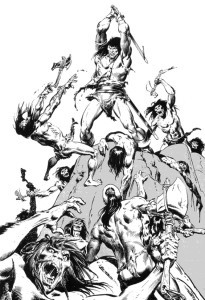 Howard: Right. And the story itself is perhaps the most barbaric of any in the entire Conan canon, with the most quoted phrase about barbarism that Robert E. Howard ever wrote.
Howard: Right. And the story itself is perhaps the most barbaric of any in the entire Conan canon, with the most quoted phrase about barbarism that Robert E. Howard ever wrote.
Bill: Against this barbaric Pictish frontier the civilized men of Aquilonia encroach with forts and colonies. Our protagonist, Balthus, is one such man — a civilized man who is no effete urban decadent, but a man of the woods and fields. Immediately upon being introduced to Balthus he is saved from a Pictish ambush by Conan, an ambush he never sees or even suspects. It is the first contrast of many in the tale between the civilized man and the pure barbarian. A little later Conan leads a small group of his best fighters against the Picts and all save the Cimmerian are lost — those fighters, hard men of the frontier, are none-the-less of the blood of civilized races. Conan, and the Picts, are barbarians of a thousand generations, men with the unerring instincts of wild animals. The rough men of the frontier can only adapt so far to such an existence.
 Balthus, as our primary point of view character, allows REH to use a tried and true technique — viewing the Cimmerian through the eyes of another. In past tales this was most often done via a damsel in distress. In “Beyond the Black River,” however, REH is not simply serving up Conan’s barbarism as characterization, but as part of the fundamental theme of the story. It is necessary to make the point that such a frontier existence, like that found in America for much of its history, exerts a change on civilized men — but that such a change only goes so far. Conan, and men like him, are not made, they are born. Slasher, a dog that has gone nearly feral after the death of his master, is a metaphor for this — and he dies alongside Balthus, heroically and out of loyalty (he after all chooses to follow the civilized man, and not the barbarian), whereas Conan survives. Conan always survives — the barbarian always triumphs.
Balthus, as our primary point of view character, allows REH to use a tried and true technique — viewing the Cimmerian through the eyes of another. In past tales this was most often done via a damsel in distress. In “Beyond the Black River,” however, REH is not simply serving up Conan’s barbarism as characterization, but as part of the fundamental theme of the story. It is necessary to make the point that such a frontier existence, like that found in America for much of its history, exerts a change on civilized men — but that such a change only goes so far. Conan, and men like him, are not made, they are born. Slasher, a dog that has gone nearly feral after the death of his master, is a metaphor for this — and he dies alongside Balthus, heroically and out of loyalty (he after all chooses to follow the civilized man, and not the barbarian), whereas Conan survives. Conan always survives — the barbarian always triumphs.
Howard: On re-reading this, I was surprised by how late Slasher turns up in the story. I had recalled that he was Balthus’ companion and misremembered that he was there from the start.
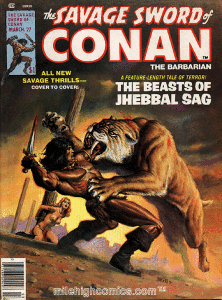 Bill: Here, the triumph is hollow. It’s only Conan’s person that survives intact, and he himself does not care about the larger ramifications of the loss of the territory on the other side of Thunder River. Indeed, he is pessimistic, and sees all too clearly what will happen. He himself was once a barbarian laying waste to an outpost of civilization at Venarium. Conan fights out of his own sense of honor and out of personal loyalty and respect, and he certainly prefers the Aquilonian colonists to the debased and wholly-savage Picts, but he only feels the losses endured by the colonists on a personal level; the larger horror of civilization being razed in fire and blood does not touch his mind. It’s this oblivious and yet adamant survival instinct that so stuns the woodsmen in the final passage of the story quoted above. Conan suffers no psychic wounds from the reversal, instead he guzzles wine and honors the fallen with a “heathen” ablution and vows to take heads in their honor — just as the vile Zogar Sag collected heads for his own revenge. The borderer realizes Conan is more akin to the savage enemies he has just faced, than he ever could be to the men who have just fallen in defense of the frontier.
Bill: Here, the triumph is hollow. It’s only Conan’s person that survives intact, and he himself does not care about the larger ramifications of the loss of the territory on the other side of Thunder River. Indeed, he is pessimistic, and sees all too clearly what will happen. He himself was once a barbarian laying waste to an outpost of civilization at Venarium. Conan fights out of his own sense of honor and out of personal loyalty and respect, and he certainly prefers the Aquilonian colonists to the debased and wholly-savage Picts, but he only feels the losses endured by the colonists on a personal level; the larger horror of civilization being razed in fire and blood does not touch his mind. It’s this oblivious and yet adamant survival instinct that so stuns the woodsmen in the final passage of the story quoted above. Conan suffers no psychic wounds from the reversal, instead he guzzles wine and honors the fallen with a “heathen” ablution and vows to take heads in their honor — just as the vile Zogar Sag collected heads for his own revenge. The borderer realizes Conan is more akin to the savage enemies he has just faced, than he ever could be to the men who have just fallen in defense of the frontier.
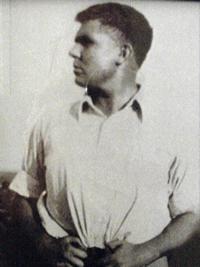
Robert E. Howard
Howard: It’s a powerful and rather subtle sentiment despite its violence, and it should be a moving tale — and yet I have to confess that it has always left me a little cold. Perhaps I shouldn’t ever say that in public, because I know many Conan fans name it as among the best. I recognize that it’s one of the most important, and the one where REH says most directly what he wants to say about barbarism, but, as I mentioned above, I bounced completely off of the story the first time I read it, being so disenchanted that I didn’t try any more Conan for years. Even after I’d embraced the writing of REH, when I read “Beyond the Black River” a second time I still wasn’t wowed, and here, upon the third read, while I may be capable of appreciating its technical aspects, I’m still not enthralled.
I’m struggling to give voice to why that is. Usually I can be more articulate about these things. I can guess that my reaction stems from several elements: I miss a stronger weird element, I would rather the story feature Conan… but in the end that doesn’t add up to enough to evoke my sour expression when I finish. I really ought to enjoy it more than I do. It’s well paced, it’s well plotted, it’s crammed with action. Conan gets to do some amazing things, and our protagonist rises to prove himself. And it’s got a cool dog character. Yet there were no places where the story held me spellbound with stunning prose or astonishing world building. As with the first and second time reading it, I struggled to maintain interest until I got to the end. It felt more like I’d finally run past the finish line, flagging and tired, than that I’d reached the end of an exhilarating roller coaster ride.
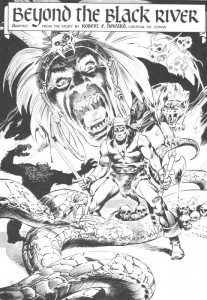 Bill: I think I can guess at a few reasons why that might be. For a start, the story is rather grim and pessimistic. That element can be found to a greater or lesser extent in many Conan tales, but here it is the focus and culmination of the story. This is not the heroic celebration of a strong free man’s victory against all odds, but rather a look the ugliness of a life and death struggle. Our primary protagonist dies — heroically, but not gloriously or victoriously. Conan, held at arm’s length for much of the story, is seen to be as much of an alien to the people he was protecting as the savage Picts that are their enemies. In short, it isn’t a fun story, and it ends with a real downer.
Bill: I think I can guess at a few reasons why that might be. For a start, the story is rather grim and pessimistic. That element can be found to a greater or lesser extent in many Conan tales, but here it is the focus and culmination of the story. This is not the heroic celebration of a strong free man’s victory against all odds, but rather a look the ugliness of a life and death struggle. Our primary protagonist dies — heroically, but not gloriously or victoriously. Conan, held at arm’s length for much of the story, is seen to be as much of an alien to the people he was protecting as the savage Picts that are their enemies. In short, it isn’t a fun story, and it ends with a real downer.
I think it’s a great story, though, and rank it perhaps just shy of the best tales in the series, but the strongest elements in “Black River” are the thematic ones; in terms of pace, language, setting, invention, and character you will find better yarns in earlier pieces. As you say, it doesn’t work well as an introduction. For established fans of Conan, and especially of REH as a writer, “Black River” does new things and says new things, or at least says them in a different way, and it works far better than REH’s earlier attempt to do something similar in “The Vale of Lost Women.”
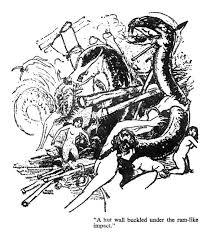 “Black River’s” unvarnished look at savagery and human nature and its downbeat ending make it a lot less enjoyable than something like “Black Colossus” or “The Tower of the Elephant,” but I think it also indicates the sincerity and seriousness of REH and his approach to the life of Conan. Many creators of a series character may have moved into a decadent or near-parody direction after so many stories, and indeed REH himself had cracked a Conan “formula” late in his initial foray into the character with tales like “Iron Shadows in the Moon.” But REH kept innovating, kept caring about his creation and using Conan and Hyboria as a lens to tell different kinds of stories. It’s extraordinary when you consider the sheer variety represented within the Conan canon, as pure a testament as any to the restless genius of its creator.
“Black River’s” unvarnished look at savagery and human nature and its downbeat ending make it a lot less enjoyable than something like “Black Colossus” or “The Tower of the Elephant,” but I think it also indicates the sincerity and seriousness of REH and his approach to the life of Conan. Many creators of a series character may have moved into a decadent or near-parody direction after so many stories, and indeed REH himself had cracked a Conan “formula” late in his initial foray into the character with tales like “Iron Shadows in the Moon.” But REH kept innovating, kept caring about his creation and using Conan and Hyboria as a lens to tell different kinds of stories. It’s extraordinary when you consider the sheer variety represented within the Conan canon, as pure a testament as any to the restless genius of its creator.
Howard: I think that’s a really astute way to look at the tale, or yarn, as Howard himself might have said. He retreated into formula a few times in this series, but he never stayed for too long. Not for him the route of Jules de Grandin and other series creators popular in their day, churning out very similar story to the delight of their readers… very, very few of those writers are still revered today.
Bill: And maybe therein lies a lesson for all artists. If I wanted to just read a Conan story for enjoyment and a sense of adventure, or hook a new reader, “Beyond the Black River” is definitely not what I would choose. But as an enlargement and exploration of one of REH’s primary themes, I don’t think it can be beat. Thank Crom the Conan canon includes both types of stories.
Howard: Well said. Next week we look at “The Black Stranger.” I hope you’ll join us.
January 4, 2016
Twilight Marathon
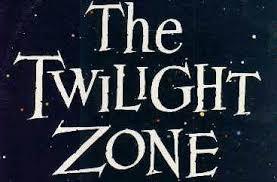 Over the New Year weekend we couldn’t help catching some of the Twilight Zone marathon on the SyFy network. As a matter of fact, because my wife and I are both fighting illness, we ended up watching more episodes than we might have, joined frequently by my son and occasionally my daughter.
Over the New Year weekend we couldn’t help catching some of the Twilight Zone marathon on the SyFy network. As a matter of fact, because my wife and I are both fighting illness, we ended up watching more episodes than we might have, joined frequently by my son and occasionally my daughter.
None of us are strangers to the show; my wife and I in particular are fans from way back. Some we’ve seen multiple times. And yet there are others that were still new to us, and I bet if we had watched the whole thing we would have found a few more, especially those odd hour-long episodes from the 4th season.
Here, in no particular order, are some of the observations we made.
Rod Serling seems like he must have been a pretty cool guy.
The women sure run oddly — sort of sashaying helplessly as they swing their limp-wristed arms bent at the elbow. What’s up there? Were women taught to run like that back then? Why?
The great episodes are just as strong as they always were, poignant, chilling, and, occasionally, heartwarming or life affirming.
 They really draw out an idea — the average or bad episodes pretty much talk an idea to death…
They really draw out an idea — the average or bad episodes pretty much talk an idea to death……yet somehow, even most of the weak ones pull you forward into the narrative to see how it will end. Even if you suspect in the first few minutes.
We’ve yet to see one of the hour-long episodes (from the 4th season) that we’d number among the best.
Everyone is both more forthright and more formal than you find people today — less standoffish, but more accustomed to referring to each other by “Mr.” or “Ms.” or other titles.
Wow, was everyone a lot thinner then, even the crowds. Maybe that’s obvious, but it’s just really striking.
Gender roles are so clearly demarcated in a different way than today, although women in the scripts are still depicted as intelligent and resourceful — and usually more insightful than some of the male characters.
Characters sure spend an awful lot of time talking about their internal emotional state — probably a stage play thing. Coming off of reading a whole lot of hard boiled prose, all that talking sure feels different.
Terror and suspense are evoked, quite effectively, by suggestion and shadow rather than blood and gore.
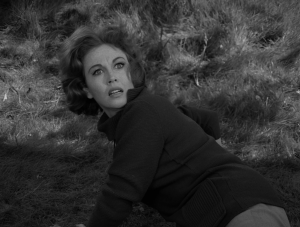 Characters are so much more serious. Matters seem more weighty. There’s a sense of responsibility and command that reminds me of the sense of command you feel when you see the original Star Trek characters making a decision, that the people behind the scripts knew about life and death choices. But then Twilight Zone’s creator was a World War II vet, and actors and other writers were probably veterans too, just like Star Trek’s producer and many writers. (Compare the weight of responsibility of original Kirk versus new movie Kirk and you can see the difference in a generation of writers that grew up seeing the horror of WWII first hand and one that usually sees war from a distance and experiences combat via video game.)
Characters are so much more serious. Matters seem more weighty. There’s a sense of responsibility and command that reminds me of the sense of command you feel when you see the original Star Trek characters making a decision, that the people behind the scripts knew about life and death choices. But then Twilight Zone’s creator was a World War II vet, and actors and other writers were probably veterans too, just like Star Trek’s producer and many writers. (Compare the weight of responsibility of original Kirk versus new movie Kirk and you can see the difference in a generation of writers that grew up seeing the horror of WWII first hand and one that usually sees war from a distance and experiences combat via video game.)Speaking of Star Trek, the orchestration of the tension music in The Twilight Zone episodes clearly presages/influenced it. Sometimes I swear I’m hearing very similar transitions and chord sequences, played on about the same number of woodwinds and strings. I haven’t noticed that in other shows of the era.
I don’t know if it could be brought back. It’s been tried, twice, but I think it lacked that key ingredient named Rod Serling. And it may be too much of its time.
There are still some we haven’t seen. We may not run out to watch them this minute, but we’ll probably tune in next year to see if there are any other undiscovered gems.
January 1, 2016
The New Year Begins
 Bill Ward and I will return next Friday with a look at one of the most famous Conan stories of all, “Beyond the Black River.”
Bill Ward and I will return next Friday with a look at one of the most famous Conan stories of all, “Beyond the Black River.”
For now, here’s hoping that we have a good New Year lying before us.
A week or so back, fellow writers Chris Jackson, Jeff Grubb, Stephan Sullivan and myself joined Dave Gross to discuss Heroic Fantasy. I hope you’ll swing by and take a look!
December 28, 2015
Cool Gifts
We had a nice Christmas here at our little tower upon the Sea of Monsters. I’ve been a bit under the weather for about a week, but it didn’t hit hard until late Saturday night, which meant I was free to enjoy Christmas with my family and extended family and spend some time with some close friends Saturday evening. Sunday I was laid pretty low, although I’m good enough now that I can climb up an old ladder to clean out some gutters. Yay for that.
Whilst lying around I did some reading for fun. I have a friend’s story to edit but didn’t feel clear enough headed to attempt that, so it is slated for this week.
 I thought I’d share my gifts with the wider world. My wife and I really only exchanged a few this year, owing to the fact that the oven and the TV both went out recently. So, for instance, I got a new one of my favorite shirts (like the one I’m wearing in this photo at Kew Gardens, where we THINK Carl Sagan might have been sitting in the original Cosmos) but my wife actually ordered it for me way back in September when there was a huge sale at SCOTTeVEST. (Speaking of which, they’re running a huge sale right now, through January 4.) Not only do I like the fit and the look, it has scads of pockets, which is great for the traveller, and convenient regardless.
I thought I’d share my gifts with the wider world. My wife and I really only exchanged a few this year, owing to the fact that the oven and the TV both went out recently. So, for instance, I got a new one of my favorite shirts (like the one I’m wearing in this photo at Kew Gardens, where we THINK Carl Sagan might have been sitting in the original Cosmos) but my wife actually ordered it for me way back in September when there was a huge sale at SCOTTeVEST. (Speaking of which, they’re running a huge sale right now, through January 4.) Not only do I like the fit and the look, it has scads of pockets, which is great for the traveller, and convenient regardless.
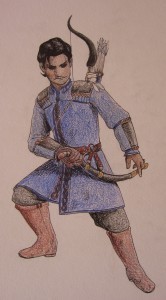
Copyright Darian Jones
My favorite gift has to be the sketch my son drew of one of the main characters in my new series. You’ll note that he has really strange eyes. He’s named Kyrkenall, and he’s the most Corwin of Amber like character I’ve ever designed — although he’s less of a long term planner. You’ll note he has a bit of a Persian look to him.
There’s an important story behind both the sword he’s clasping and the great black horned blow over his shoulder. He’s one of the last Altenerai, the heroes of the realm whose superhuman prowess is legendary. That uniform coat he’s wearing is what’s known in some parts of Asia as a khalat.
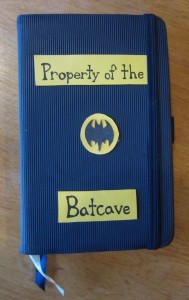 My daughter altered my favorite notebook for me, which is something I often carry in the pocket of my shirt.
My daughter altered my favorite notebook for me, which is something I often carry in the pocket of my shirt.
I’m honestly surprised how well the alterations are holding up being taken in and out of my pocket! This is a Sigel, which remains my favorite model. (I went into probably too much detail earlier this year about writing notebooks and why I like carrying one with me.)
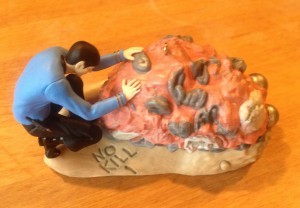 Just before Christmas a little package arrived from Scott Lynch, and inside was a treasure that’s been delighting me ever since. Currently it’s sitting on the kitchen desk, mostly because it amuses me that my wife finds it so hideous, but also because my son and I keep wandering past to hit the button and listen to Spock and Kirk talk about the Horta. You can even hear Spock shout: “Pain!”
Just before Christmas a little package arrived from Scott Lynch, and inside was a treasure that’s been delighting me ever since. Currently it’s sitting on the kitchen desk, mostly because it amuses me that my wife finds it so hideous, but also because my son and I keep wandering past to hit the button and listen to Spock and Kirk talk about the Horta. You can even hear Spock shout: “Pain!”
It’s designed as a Christmas ornament, but I’ll probably move it to my office desk after the New Year.
There were also some necessities for the truck — over the years I’ve lost or misplaced a number of bungee cords and tighteners and now I have a wonderful set of them. And the wife and I also have some gift cards we’ll be putting to use towards a new television.
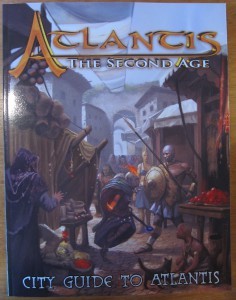 In the months before the holidays I sold off a lot of stuff, either via Ebay or by trading it to Wayne’s Books. Some of the money I put straight away to some expenses I’d accrued, but some of the money I made selling off books I naturally used to buy more books. Because I was too busy writing to actually read any of those books, I counted them as Christmas presents, especially because I got to read them two days after Christmas after being flattened by a nasty head/chest cold.
In the months before the holidays I sold off a lot of stuff, either via Ebay or by trading it to Wayne’s Books. Some of the money I put straight away to some expenses I’d accrued, but some of the money I made selling off books I naturally used to buy more books. Because I was too busy writing to actually read any of those books, I counted them as Christmas presents, especially because I got to read them two days after Christmas after being flattened by a nasty head/chest cold.
First up was the new(ish) supplement for Atlantis: The Second Age detailing the city sectors of the lost metropolis, at least as envisioned by the fine folks at Khepera Publishing. I happen to be a huge fan of their Atlantis product line, although I don’t know that I’ve ever mentioned that, or discussed it in a review. I should remedy that next year.
I love reading game books with great world building — strange places that are well envisioned and crammed with story hooks and interesting people and creatures. Doing it well is an art, and it has a lot in common with novel writing. I happen to think the Atlantis books are great examples of doing it right. They’re based on some books originally written by Stephen Michael Sechi, the fellow behind Talislanta, one of my all-time favorite game settings.
The world of Atlantis also happens to be a great sword-and-sorcery setting. Tell you what, I’ll cover it in more detail in the coming months. You can find out more about it here.
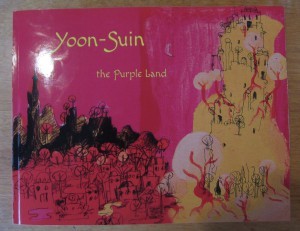 I also picked up Yoon-Suin, a fabulous book that helps you generate your own fantastic Asian/Tibetan city and surrounding countryside stuffed full of the weird and wonderful. It’s crammed full of great world building and prose poetry. You can read excerpts of the colorful travelogue here, find other tidbits from the author in a related vein at his website, here, or purchase Yoon-Suin at Lulu, here (it’s also available as a PDF — although I got it in print, with a little help from a great holiday Lulu coupon). Even if you’re not a gamer you really ought to read the travelogue. It’s just wonderfully done.
I also picked up Yoon-Suin, a fabulous book that helps you generate your own fantastic Asian/Tibetan city and surrounding countryside stuffed full of the weird and wonderful. It’s crammed full of great world building and prose poetry. You can read excerpts of the colorful travelogue here, find other tidbits from the author in a related vein at his website, here, or purchase Yoon-Suin at Lulu, here (it’s also available as a PDF — although I got it in print, with a little help from a great holiday Lulu coupon). Even if you’re not a gamer you really ought to read the travelogue. It’s just wonderfully done.
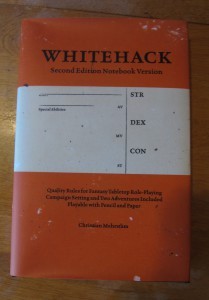 I loved Whitehack so much (I mentioned it last week, I think) that I picked up a copy in hardback, courtesy of a sale that’s running through the first part of January. I mentioned its elegant game system, but I didn’t mention that it, too, has a cool little campaign setting. Whitehack is something I should discuss in more detail in the coming weeks.
I loved Whitehack so much (I mentioned it last week, I think) that I picked up a copy in hardback, courtesy of a sale that’s running through the first part of January. I mentioned its elegant game system, but I didn’t mention that it, too, has a cool little campaign setting. Whitehack is something I should discuss in more detail in the coming weeks.
While ill I also read my son’s new Avatar: The Last Airbender graphic novels, one of his Christmas gifts. They were awfully close in style and feel to the original series, which is a big hit in the Jones household. I don’t think that they ever quite dealt with the madness of Princess Azula in a satisfactory fashion, but she’s not a character in the first or third of the graphic novel series. I though the third of the graphic novels particularly strong, and I’m looking forward to seeing the fourth, which isn’t completed yet, or at least isn’t available yet in hardback format.
Here’s hoping that your own holidays are treating you right, and that you’re spending quality time with friends and family. Also, illness free time.
December 23, 2015
Web Thoughts
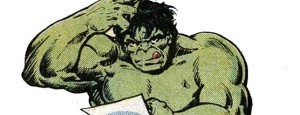 It’s always a little strange to me that I maintain a web site. It’s not something I ever planned to do, but I was told, some time ago, that a writer really needs to maintain a presence out here in the world wide web, and so I do.
It’s always a little strange to me that I maintain a web site. It’s not something I ever planned to do, but I was told, some time ago, that a writer really needs to maintain a presence out here in the world wide web, and so I do.
I’ve come to enjoy it for the most part. I love the opportunity to meet other folks who enjoy the same kind of stuff I do, and to work with fine folks like Bill Ward and Chris Hocking and discuss some excellent forgotten fiction.
Occasionally I get a note from someone who really found one of my writing posts helpful, and that’s always quite nice. My most successful post, ever, seems to be the one I wrote about a prayer to the muses for inspiration, and it continues to pull in people who have no interest in anything else on the site, but who found that prayer of use. I’m glad of that.
Some days I’m just too busy to post anything, especially when deadlines loom. Some days I find I have nothing to say, and some days I actually have a WHOLE lot I want to say and am short on time. I guess I’m always short on time.
And then sometimes I go to bed feeling just fine and wake up with every joint aching. Like today. No fun, that. I sure hope this is a 24 hour virus so that I can get to enjoying some holiday time off when it hits. For now I’m going to get some food in so I can take some ibuprofen, and then get back to my “honey do” list.
I’ll try to be more entertaining later in the week!
For now, here are some interesting links:
First, James Reasoner looks at another great Leigh Brackett story.
Second, a great Savage Sword of Conan discussion. I laughed, I cried, well, I don’t think the latter, but it’s a neat place to visit if you’re curious about how well various stories hold up.
December 21, 2015
Winter Update 2
I turned over my new book to my agent last week. The final third has some spots that are pretty rough yet, and I’ll be sanding those down after the next week. Right now I’m trying to catch up on some long overdue house organization. Thankfully gift shopping is nearly done, barring any sort of shipping shenanigans.
After being pedal to the metal on fiction writing, I hope to pick up some books I’d started and maybe start some new(isn) ones. I’ve also a friend’s manuscript to read. And I hope to do some gaming over the coming weeks. Speaking of which, I’ve picked up some great low-cost role-playing books over the last month and I’ve been meaning to talk them up, because I’ve found some great stuff. I like them so well that I’ll probably take the review over to Black Gate so more people hear about them. For the meanwhile, though, I’ll just say that these two products have really innovative ways to approach old school gaming, and that if you’re a fantasy table-top gamer you really need to check them out:
Whitehack — the simplest way to run old D&D I’ve seen that also manages to accomplish all the things I was always frustrated that D&D couldn’t do. The one and only book is on sale for less than $ 7.00 through January.
The B/X Rogue — an elegant way to approach any Thief or Rogue or related classes. It’s simple, intuitive, and so clearly explained I’m simply astonished no one has ever done it this way before. Really impressive, and yours for only $1.50!
December 18, 2015
Conan Re-Read: “The Servants of Bit-Yakin”
 Bill Ward and I are starting our read through of the Del Rey Robert E. Howard collection The Conquering Sword of Conan. This week we’re discussing “The Servants of Bit-Yakin,” occasionally known as “Jewels of Gwahlur.” We hope you’ll join in!
Bill Ward and I are starting our read through of the Del Rey Robert E. Howard collection The Conquering Sword of Conan. This week we’re discussing “The Servants of Bit-Yakin,” occasionally known as “Jewels of Gwahlur.” We hope you’ll join in!
Howard: I expected to like this one less. I try to walk into reading these stories with a pretty open mind, but in the case of Bit-Yakin I recently caught a few articulate REH fans writing about how it was their least favorite, and of course Patrice Louinet mentions, in the concluding essay to the book, that it was probably written quickly to help build up the stock of Conan stories in the Weird Tales inventory. With that in mind I thought I’d be reading more filler. Yet I ended up enjoying it a lot more than “A Witch Shall be Born” — apart from that one great scene we discussed last week — and there’s nothing in this story that touches that.
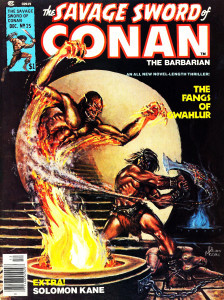 Bill: I like it as well, and put it roughly on par with stories like “Xuthal of the Dusk” and “Iron Shadows in the Moon.” I recently read a good Dark Horse adaptation of it (as “The Jewels of Gwahlur,” its Weird Tales name) so it was fresher in my mind than many of our recent rereads.
Bill: I like it as well, and put it roughly on par with stories like “Xuthal of the Dusk” and “Iron Shadows in the Moon.” I recently read a good Dark Horse adaptation of it (as “The Jewels of Gwahlur,” its Weird Tales name) so it was fresher in my mind than many of our recent rereads.
Howard: Yes, I re-read the adaption in the Savage Sword of Conan, which worked quite well. Even acknowledging it’s one of the lesser Conan stories it’s still enjoyable. It feels a lot less like a re-tred of pre-existing scenes the way some of the other minor yarns featuring the famous Cimmerian. It’s not without some issues, but it has some some excellent moments as well. The opening climb is a great attention getter, and provides us numerous moments that are revealing of Conan’s character. I especially like how Conan’s completely unfazed by the repulsive mummy. To him it’s just another dead thing, and Conan’s lack of fear or even revulsion when he encounters it is completely counter to what a civilized man would feel.
Bill: Yes, he just snatches the mummy’s scroll and keeps on climbing. Interestingly enough, he can also later read the obscure language on the scroll, which shows the other side of his character.
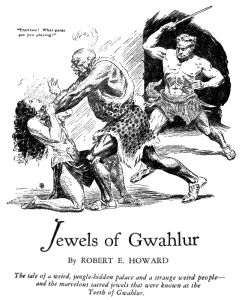 Howard: Right — by this point in his life he’s picked these things up. Conan’s hardly a monosyllabic brute, or unchanging. There’s another character revealing moment near the tale’s end, after Conan’s lost the jewels. Muriela thinks that he’s going to be furious. A civilized man would be full of recriminations and anger and regret, but Conan just shrugs. He knows the moment is over and there’s no need to waste energy worrying about might have beens.
Howard: Right — by this point in his life he’s picked these things up. Conan’s hardly a monosyllabic brute, or unchanging. There’s another character revealing moment near the tale’s end, after Conan’s lost the jewels. Muriela thinks that he’s going to be furious. A civilized man would be full of recriminations and anger and regret, but Conan just shrugs. He knows the moment is over and there’s no need to waste energy worrying about might have beens.
There are numerous splendid scenes describing the eerie dead city, and some evocative phrases. Robert E. Howard knew very well that there was no point in taking your characters some place that wasn’t interesting to look at, and the entire lost hidden city with its concealed entrance and underground river (where hideous ape men dine on corpses they’ve fished from dark waters) is first rate.
Bill: Indeed, the narration remains in the lost world of the “vast natural amphitheater” of the Oracle of Alkmeenon for the whole story, the rest of the expository details of Keshan and the build-up to the conflict between Conan and Zargheba and Gwarunga is given as backstory. This is unusual to the point of being, possibly, unique in a Conan story. Even stories set in predominantly one location usually begin with Conan moving out of one predicament or set up and onto the primary stage of the story.
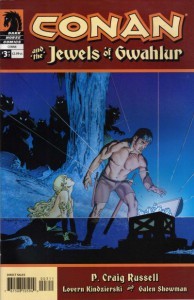 Howard: The plot itself is a little flimsy and sends Conan racing back and forth enough times it’s a little like watching a tennis match. It’s a bit hard to believe that Conan has worked so hard to get to his place and its jewels without knowing very much about them, and all the back and forth with the perfectly preserved oracle as well as the reason the servants are there doesn’t hold up to that much scrutiny. Yet there is great momentum, and some nice chills (the discovery of the severed head, for instance) and other revealing character moments. Muriela’s not one of Conan’s more interesting lady loves, although I rather like the way she acts like the oracle (and I thought it clever that Conan catches on because of her Corinthian accent).
Howard: The plot itself is a little flimsy and sends Conan racing back and forth enough times it’s a little like watching a tennis match. It’s a bit hard to believe that Conan has worked so hard to get to his place and its jewels without knowing very much about them, and all the back and forth with the perfectly preserved oracle as well as the reason the servants are there doesn’t hold up to that much scrutiny. Yet there is great momentum, and some nice chills (the discovery of the severed head, for instance) and other revealing character moments. Muriela’s not one of Conan’s more interesting lady loves, although I rather like the way she acts like the oracle (and I thought it clever that Conan catches on because of her Corinthian accent).
Bill: I will admit to being a little disoriented with the “tennis match” in places, particularly after the first encounter with Gwarunga. I think it’s fair to say the story could be a little leaner and more tightly plotted, but, as that never really feels like a problem in the way that “Witch’s” flaws do, I think that goes to show the power of direct narrative when you are trying to move a story forward. “Witch” relied on a lot of exposition and second hand information when presenting plot points, “Bit-Yakin” confines exposition to backstory, and gives us an undiluted narrative foreground for all the action in the tale. Even if it gets slightly confusing, it doesn’t matter, because we are along for the ride in a way that a story like “Witch” makes impossible.
Howard: I think that’s all fair. It might have needed another pass, but it didn’t require as much brushwork as “Witch,” a tale that seemed like it was an outline in several places. You’re probably right that it’s easier to forgive this one its flaws because it’s direct narrative and that it’s Conan we’re watching.
Bill: I like the backstory for this one as well. The “Teeth of Gwahlur” may not really be explained, but the manipulation of these 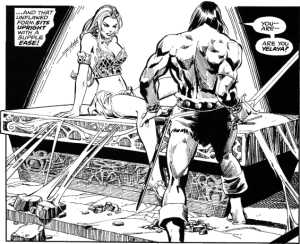 isolated civilizations on the edge of the known world by foreign adventurers — and by Bit-Yakin himself in ages past — is a compelling idea and a great way to kick off a conflict. There are shades of Haggard here, and another Conan, Arthur Conan Doyle, whose The Lost World gave us a remote, inaccessible plateau, and some horrible ape-men to go with it.
isolated civilizations on the edge of the known world by foreign adventurers — and by Bit-Yakin himself in ages past — is a compelling idea and a great way to kick off a conflict. There are shades of Haggard here, and another Conan, Arthur Conan Doyle, whose The Lost World gave us a remote, inaccessible plateau, and some horrible ape-men to go with it.
Thutmekri, the mastermind behind the rival attempt to grab the jewels, is probably my favorite minor character in this piece, and he’s only mentioned a few times and never encountered. To me he sounds like a Stygian version of Conan — and when was the last time we ever heard of an adventurer from the black lands of Stygia? — and his plan to nab the jewels is good enough that Conan plans to adopt the same scheme for himself and Muriela at the story’s end. Thutmekri just begged to be a reoccurring foil for the Cimmerian, I’m surprised he never took off in comics or pastiches the way Toth-Amon did.
Howard: Roy Thomas, the mastermind behind The Savage Sword of Conan and the regular Marvel Conan the Barbarian comics, used Thutmekri multiple times, having him appear in several prequel stories before this. That just goes to show how carefully Thomas dealt with the series, and how well-thought out his approach to writing pastiche was. It may seem obvious to a real Conan fan that you’d carefully comb through the stories to find possibilities like this and expand upon them, but then all you have to do is look out upon the vast swathe of ham-handed Conan pastiche that occurred before and after Thomas and realize it must not be obvious at all. The man loved the Conan stories and dealt with them reverently. Thomas was hampered a little both by comic conventions and having to deliver the tales in a monthly format, yet even with occasional clunker issues his run was remarkable, and he really should be celebrated as one of the best of the pastiche writers.
Bill: That’s good to hear, my bit of googling didn’t turn much up on Thutmekri, I’ll have to check out those Thomas tales some time. Overall, I’d rate “The Servants of Bit-Yakin” as on par more-or-less with the solid run of lesser Conan stories, and a nice return to form after last week’s tale. Exotic locale, frantic pace, beautiful sidekick, lost ruins, supernatural peril — a lot from the Conan checklist is here, but the story itself also strays into some original territory which helps keep it fresh.
Howard: I agree. It’s no “Tower of the Elephant” but it’s a fun ride.
Here’s usually where I thank you for coming and invite you to enjoy us next week. But next week, rather than bringing you a very special Cimmerian Christmas special, we’ll just be taking the day off. The week after, though, we’ll be discussing one of the most famous Conan stories, “Beyond the Black River.” We DID want to point you toward another Conan re-read series over at Black Gate. John Fultz is re-reading the Savage Sword of Conan. He’s up to volume 3. It’s definitely worth a look! John goes into great detail about both the stories and the art quality.
Howard Andrew Jones's Blog
- Howard Andrew Jones's profile
- 368 followers



